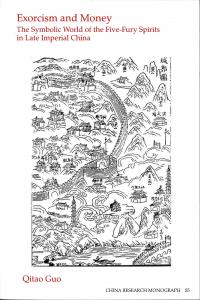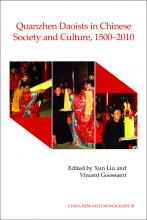Exorcism and Money
Exorcism and Money
Qitao Guo
This study analyzes the identities of the five-fury spirits in light of the cult's historical linkages with local society in southern Anhui and with other religious traditions in a larger context. These two contexts interacted in complex ways to generate, around the time of the mid-Ming, a localized religious order. Guo explores not only how history transformed the symbolic order, but also how history itself was symbolically ordered and reordered in the process.
As a nonprofit academic press, we need your support to publish our books. Your gift can help us make more of our titles available as e-books. DONATE NOW
Title information
This study analyzes the identities of the five-fury spirits in light of the cult's historical linkages with local society in southern Anhui and with other religious traditions in a larger context. These two contexts interacted in complex ways to generate, around the time of the mid-Ming, a localized religious order. Guo explores not only how history transformed the symbolic order, but also how history itself was symbolically ordered and reordered in the process. This monograph is intended to add a symbolic dimension to a classic issue in the study of Ming-Qing social history: the state-society relation on the one hand and the elite-commoner and gentry-merchant relations on the other. By tracing the integration and gentrification of localized gods back to the mid Ming, Guo also demonstrates how popular religion accompanied the socioeconomic changes that swept the entire empire during the sixteenth century.
Qitao Guo
Qitao Guo is associate professor of history at the University of California, Irvine.
Ph.D. University of California, Berkeley
Exorcism and Money
Acknowledgments – vi
Map of Late Imperial Southern Anhui – vii
Chinese Dynasties – viii
Reign Periods of the Ming and Qing Dynasties – ix
Abbreviations – x
Figures – xi
Introduction – 1
Part I: Integrating Local Exorcism: The Evolution of the Symbolic World of the Five Furies
1. The Origins of Wuchang Exorcism – 21
2. Ming Taizu, Religious Hierarchy and Ghost Exorcism – 40
3. The Rise of Local Pantheons in the Mid Ming – 48
Part II: Co-opting Ghosts and Money: Popular Wuchang Symbolism in Late Imperial Huizhou
4. Synopsis of Huizhou Social History – 87
5. The New Identities of Wuchang – 101
6. The Social Dimension of the Wuchang Cult – 157
Conclusion – 181
Bibliography – 197
Index – 215
|
JOURNAL REVIEWS |
|
"Qitao Guo's study of a group of exorcistic deities known as the Five Furies (Wuchang 五昌) successfully explores the complex factors underlying the growth of communal religious traditions in late imperial China….His efforts have resulted in a work that clearly shows the Wuchang to be "Janus-faced" deities that could be represented as either ghosts or gods." ~Paul R. Katz, Institute of Modern History, Academia Sinica, in China Review International (http://www.jstor.org/stable/23732925) |
|
"The depth and detail of this study make it invaluable for anyone interested in the development of Chinese religion and more broadly for the light that it sheds on the ways that interactions among various elites, commoners, and the state shaped Chinese culture....[T]he book offers enormously rich information about the varying symbolic interests of different groups: merchants who use the Five Furies as gods of wealth, literati who subordinate the deities to lineage tutelary gods, commoners who worship them for general protection, and so on. His specific contribution to our knowledge of the Five Furies cult is remarkable, and the book offers extraordinarily rich material for the examination of religion more broadly in China." ~Robert P. Weller, Boston University, in The Journal of Asian Studies (http://www.jstor.org/stable/25075689) |




